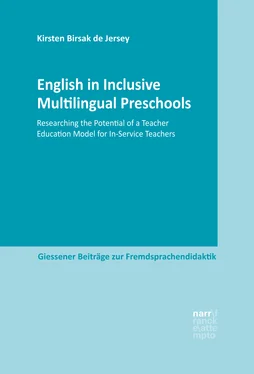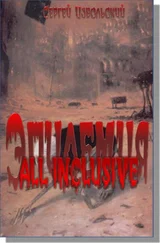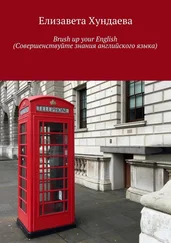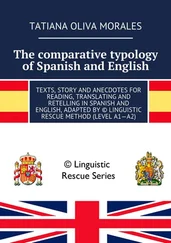Kirsten Birsak de Jersey - English in Inclusive Multilingual Preschools
Здесь есть возможность читать онлайн «Kirsten Birsak de Jersey - English in Inclusive Multilingual Preschools» — ознакомительный отрывок электронной книги совершенно бесплатно, а после прочтения отрывка купить полную версию. В некоторых случаях можно слушать аудио, скачать через торрент в формате fb2 и присутствует краткое содержание. Жанр: unrecognised, на английском языке. Описание произведения, (предисловие) а так же отзывы посетителей доступны на портале библиотеки ЛибКат.
- Название:English in Inclusive Multilingual Preschools
- Автор:
- Жанр:
- Год:неизвестен
- ISBN:нет данных
- Рейтинг книги:3 / 5. Голосов: 1
-
Избранное:Добавить в избранное
- Отзывы:
-
Ваша оценка:
- 60
- 1
- 2
- 3
- 4
- 5
English in Inclusive Multilingual Preschools: краткое содержание, описание и аннотация
Предлагаем к чтению аннотацию, описание, краткое содержание или предисловие (зависит от того, что написал сам автор книги «English in Inclusive Multilingual Preschools»). Если вы не нашли необходимую информацию о книге — напишите в комментариях, мы постараемся отыскать её.
English in Inclusive Multilingual Preschools — читать онлайн ознакомительный отрывок
Ниже представлен текст книги, разбитый по страницам. Система сохранения места последней прочитанной страницы, позволяет с удобством читать онлайн бесплатно книгу «English in Inclusive Multilingual Preschools», без необходимости каждый раз заново искать на чём Вы остановились. Поставьте закладку, и сможете в любой момент перейти на страницу, на которой закончили чтение.
Интервал:
Закладка:
It has been statistically established by the Special Eurobarometer 243 that “English is perceived as the most useful language by citizens in both new and old member states” (European Commission, 2006, p. 31). According to the latest data, 97 % of all Europeans study English as a first foreign language and languages other than English, French or German are rarely studied (European Commission, 2017). Nevertheless, the European Commission in the same year “reiterated the ambition of ‘enhancing the learning of languages, so that more young people will speak at least two European languages in addition to their mother tongue’ " (European Commission, 2018, p. 2; italics in original).
This development may seem at first to contradict European education policy’s aspiration of plurilingual education and the diversification of language teaching as their additional long-term goal: “Furthermore, the co-existence of many languages in Europe is a powerful symbol of the European Union's aspiration to be united in diversity, one of the cornerstones of the European project. Languages define personal identities but are also part of a shared inheritance” (p. 2). But on closer scrutiny this is not the case as it is not a question of ‘either – or’, but of ‘both – and’: while early childhood language development obviously needs to focus on the language of instruction (German), and – in the interest of equal chances for all the children – on a foreign language, children’s first language education must not be neglected:
Deutlich größeres Gewicht (als Dialekte oder Nachbarsprachen, zum Beispiel) wird auf die Wertschätzung und Berücksichtigung der Herkunftssprachen und unterschiedlichen Familienkulturen der Kinder gelegt und vielfach betont, dass andere Familiensprachen als Chance und Bereicherung, nicht als Belastung oder Risiko zu betrachten seien. Es wird nahegelegt, die verschiedenen Herkunftssprachen am besten durch Elternbeteiligung einzubinden. (Sambanis, 2016, pp. 174-175)
Considering the roles of different languages in elementary education, in my research project English was selected as the foreign language to be introduced in the inclusive state preschool for its relevance as a commonly shared European language that contributes to mutual understanding of people with diverse heritage languages. At the same time, English would be integrated in a preschool, which is characteristically multicultural and therefore multilingual. Consequently, it would support European language policy recommendations in a context where at the same time all the languages represented by the children are equally respected and important in their own right (→ chapter 6.2.2). In practice, this means that conscious attention is given to valuing the children’s many heritage languages as a principle in the state preschool, which was selected for the research project. Two examples illustrate this preschool’s language policy: when entering the preschool there is a large paper archway greeting everybody with good morning in the various languages of the children and three times a year they have story-day in which different stations are set up throughout the preschool as story-corners. Various mothers, fathers or grandparents who represent the different cultures and languages come to the preschool with their children’s storybooks and share them in one of the stations. The children are free to go from one station to the other to listen to the stories and have contact with the various languages. As I am a native speaker of English, I read English children’s books in one of the stations. During the day, at various opportunities, the preschool teachers engage the children in comparing words and trying to pronounce them, which is an experience that makes both the children and the teachers aware of the diversity of languages and the excitement of getting involved in learning them. It also values children’s language competences and contributes to a good rapport with their teachers. For example, I remember a situation when I could not manage the right pronunciation of a word in Turkish and suddenly I had about ten children around me all trying to teach me. Because of the philosophy to uphold mutual respect for all languages, the teacher education project that is the focus of the study here therefore began by the children telling everybody which other languages they spoke. During the participatory demonstration lessons (→ chapter 5.7.1) the opportunity was taken to encourage children to share their mother tongues and through this the children felt free to join in and share words in their various languages.
Relevance of an early start in English
Early language acquisition research commonly agrees that children tend to approach second or foreign language learning in a natural way showing only little or no anxiety and inhibitions as they are still in the early phases of coming to terms with their first language or languages. They have the ability to acquire languages intuitively and are “more attuned to the phonological system of the new language” (Pinter, 2006, p. 29).2 But this general statement needs to be substantiated with regard to the following specifications. Referring to Pinter (2011) Copland & Garton (2014) note that there are contradictory results of previous studies on the ‘younger is better’ hypothesis. They therefore note that “there is no conclusive evidence for the supposed benefits of early introduction of English into the curriculum” (p. 224). They argue that if early English is offered, success depends on the quality of “age-appropriate teaching” and “learners’ attitudes towards the language and their motivation to learn” (p. 225). In summarizing the state of available research findings, they note that
research-based publications into effective practices for teaching YLs continue to be quite rare. Database searches … still yield very few examples of empirical studies about the effect of pedagogies on early language learning. … It is clear that there remains a lack of classroom-based studies and ‘young learners’ in general remains an under-researched area. (pp. 226, 227)
It is for similar reasons that Piske (2017) also critically examines the reasons “why the high expectations regarding the outcomes of early foreign language programs many people appear to have had in the beginning have not always been met” (p. 45). Early foreign language education was introduced on the assumption that there is a critical or sensitive period during which children acquire languages more successfully than adolescents or adults (for a summary on research regarding the critical period hypothesis see pp. 45-47). The monocausal explanation of attainment in L2 learning has “led several researchers to ignore the potential influence of variables other than age-related variables on success in L2 Learning” (p. 46). They relate to the quality and amount of exposure to the target language, learners’ opportunities to use the language or teachers’ ability to create motivating learning environments (→ chapter 5.8. for further details). Finally, empirical studies that have been published under the heading of an early start in English have either researched children’s language competence development in primary school settings3 or in bilingual immersive elementary contexts (Piske et al., 2016; Seifert, 2016). Although results from both contexts support the introduction of an early start in English , the contexts that are represented in these empirical research studies differ from the language acquisition context of the multilingual inclusive state preschool which is the focus of the preschool teacher education study that is presented here. Results of these empirical studies can therefore not be directly transferred to this research. No studies have researched children’s English competence development in heterogeneous, non-privileged, inclusive, multi-lingual preschool classrooms to date. This has been criticized by language acquisition researchers and European education policy alike:
Читать дальшеИнтервал:
Закладка:
Похожие книги на «English in Inclusive Multilingual Preschools»
Представляем Вашему вниманию похожие книги на «English in Inclusive Multilingual Preschools» списком для выбора. Мы отобрали схожую по названию и смыслу литературу в надежде предоставить читателям больше вариантов отыскать новые, интересные, ещё непрочитанные произведения.
Обсуждение, отзывы о книге «English in Inclusive Multilingual Preschools» и просто собственные мнения читателей. Оставьте ваши комментарии, напишите, что Вы думаете о произведении, его смысле или главных героях. Укажите что конкретно понравилось, а что нет, и почему Вы так считаете.











